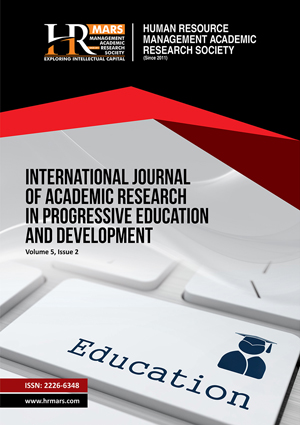
ISSN: 2226-6348
Open access
The education field is one of the aspects that have been linked to the economic field. Based on the Malaysian Education Blueprint 2013–2025, the learning environment is one of the aspects that should be improved in order to achieve the best academic performance. The aim of this study is to review a learning environment that influences achievement in the education field. This paper explores the meaning of the psychosocial learning environment by various researchers and even explores one of the most popular dimensions of the psychosocial learning environment, such as teacher and student relationships that is believed to be capable of affecting the academic performance. A good relationship between the teacher and student can leave positive impacts on the student’s level of motivation and attitude towards their learning. The findings of previous researchers were also included to support the arguments used in this study.
Ballantine, J. H. (1997). The sociology of education; A systemic analysis. Edisi ke-4. New Jersey: Pearson Education Inc.
Che Ahmad, C. N., Osman, K., & Halim, L. (2013). Persekitaran pembelajaran aspek fizikal dan psikososial. Bangi: Universiti Kebangsaan Malaysia.
Chen, C., Fan, J., & Jury, M. (2017). Are perceived learning environments related to subjective well-being?? A visit to university students. Learning and Individual Differences, 54, 226–233. https://doi.org/10.1016/j.lindif.2017.01.001.
Colvin, C., & Schloscer, L. K. (1998). Developing academic confidence to build literacy: What teachers can do. Journal of Adolescent and Adult Literacy, 41(4): 272-281.
Fraser, B. J. (1994). Classroom and School Climate. In. Gabel, D. (Ed.). Handbook of Research on Science Teaching and Learning, 493-541. New York: Mac-Millan.
Fraser, B. J. (1998). Classroom Environment Instruments: Development, Validity and Applications. Learning Environments Research, 1, 7–33.
Ginott, H. (1972). Teacher and child. New York: Avon Books.
Gorham, J., & Christopel, D. M. (1990). The relationship of teacher’s use of humour in the classroom to Immediacy and Student Learning. Communication Education, 39: 46-61.
Hassan, A., & Mohd, A. (1999). Komunikasi untuk guru. Utusan Publications & Distributors Sdn. Bhd.
Biggs, J. (1999). What the Student Does: teaching for enhanced learning. Higher Education Research & Development, 18:1, 57-75.
Joyce, B., & Weil, M. (1996). Models of teaching (5th ed.). Englewood Cliffs, NJ: Prentice-Hall.
Ishak, M. N., & Mohammad, N. S. (2001). Gaya pertautan dan komitmen terhadap profesion perguruan di kalangan guru-guru pelatih. Kertas Kerja International Conference on Challenges and prospects in teacher education. Shah Alam: Concorde Hotel.
Nor, M. R. (2005). Perkaitan di antara budaya sekolah dengan pencapaian akademik pelajar di Negeri Sembilan [Tesis Doktor Falsafah, Universiti Kebangsaan Malaysia].
Saad, M. B. (1997). Korelasi antara persekitaran pembelajaran dengan pendekatan pembelajaran dengan pencapaian Ekonomi STPM [Tesis Sarjana Pendidikan, Universiti Kebangsaan Malaysia].
Mokhtar, S. B. (2012). Faktor persekitaran pembelajaran, pendekatan pembelajaran dan kemahiran generik dalam kalangan pelajar politeknik [Tesis Doktor Falsafah, Universiti Kebangsaan Malaysia]
Okula, S. (1999). Creating a positive school culture: Strategies that work. Business Education Forum, 54 (2), 7-13.
Puteh, M., Adnan, M., Ibrahim, M. H., Noh, M. N., & Che Ahmad, C. N. (2014). An analysis of comfortable teaching and learning environment?: community response to climate change in school. Procedia-Social and Behavioral Sciences, 116, 285–290. https://doi.org/10.1016/j.sbspro.2014.01.209
Rahim, N. H. Z, Rashid, M. A., & Hamzah, R. (2015). Hubungan antara penglibatan dalam teknikal dan vokasional. Journal of Human Capital Development, 8(1), 105–120.
Ramsden, P. (1991). A Performance Indicator of Teaching Quality in Higher Education: The Course Experience.
Rudduck, J., Chaplain, R., & Wallace, G. (1996). Reviewing the conditions of learning in school. In: Rudduck, J., Chaplain, R., & Wallace, G., Eds., School Improvement: What Students Can Tell Us? London: David Fulton Publishers, 170-176.
Tessmer, M., & Harris, D. (1992). Analyzing the instructional setting: Environmental analysis. London/Bristol, PA: Kogan Page/Taylor and Francis.
Wiseman, M., & Bogner, F. X. (2003). A higher-order model of ecological values and its relationship to personality. Personality and Individual Differences, 34, 783–794.
In-Text Citation: (Jamaluddin et al., 2021)
To Cite this Article: Jamaluddin, N. S., Kadir, S. A., Alias, S. N., & Abdullah, A. (2021). A Review of Psychosocial Learning Environment. International Journal of Academic Research in Progressive Education and Development, 10(3), 804–808.
Copyright: © 2021 The Author(s)
Published by HRMARS (www.hrmars.com)
This article is published under the Creative Commons Attribution (CC BY 4.0) license. Anyone may reproduce, distribute, translate and create derivative works of this article (for both commercial and non-commercial purposes), subject to full attribution to the original publication and authors. The full terms of this license may be seen at: http://creativecommons.org/licences/by/4.0/legalcode